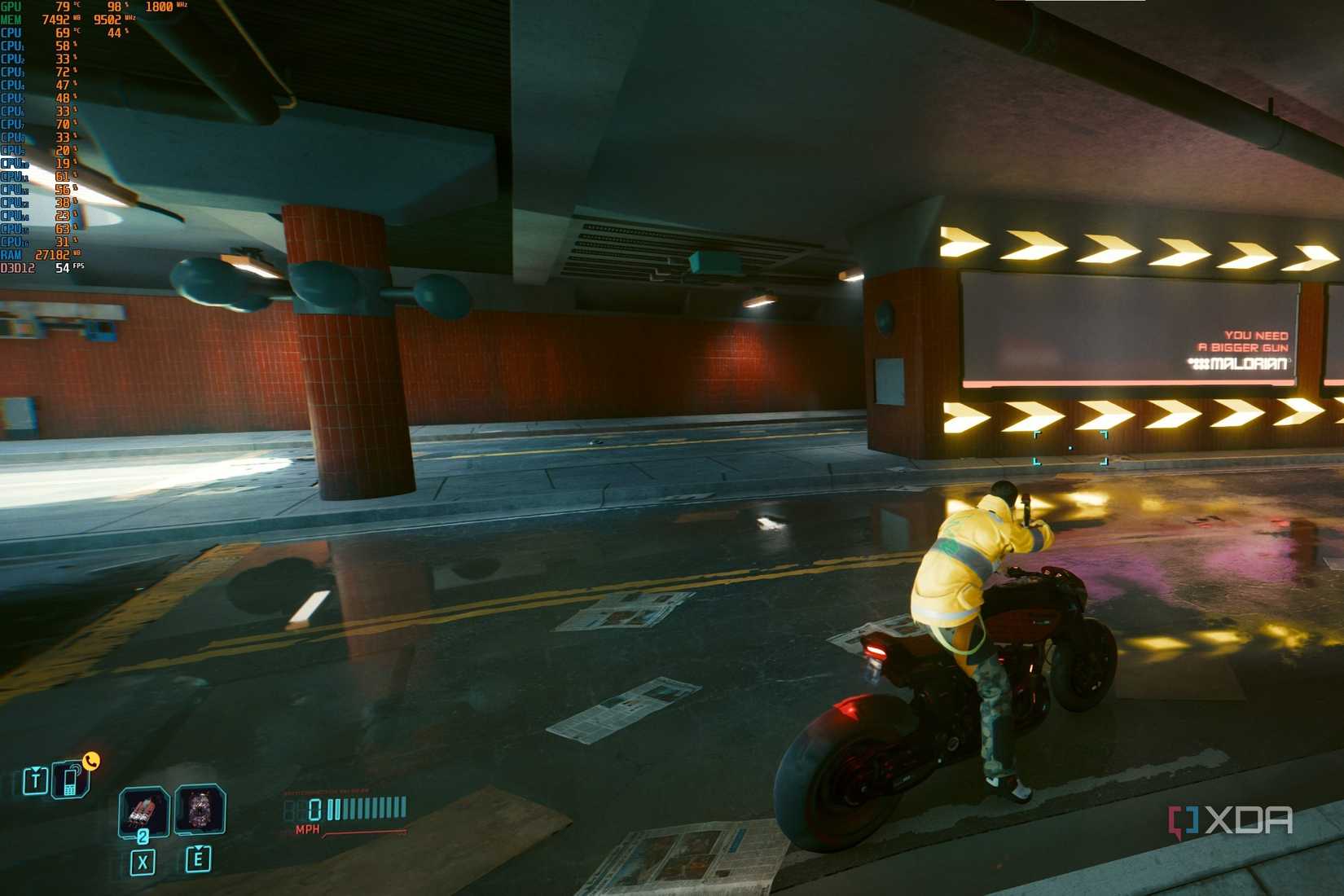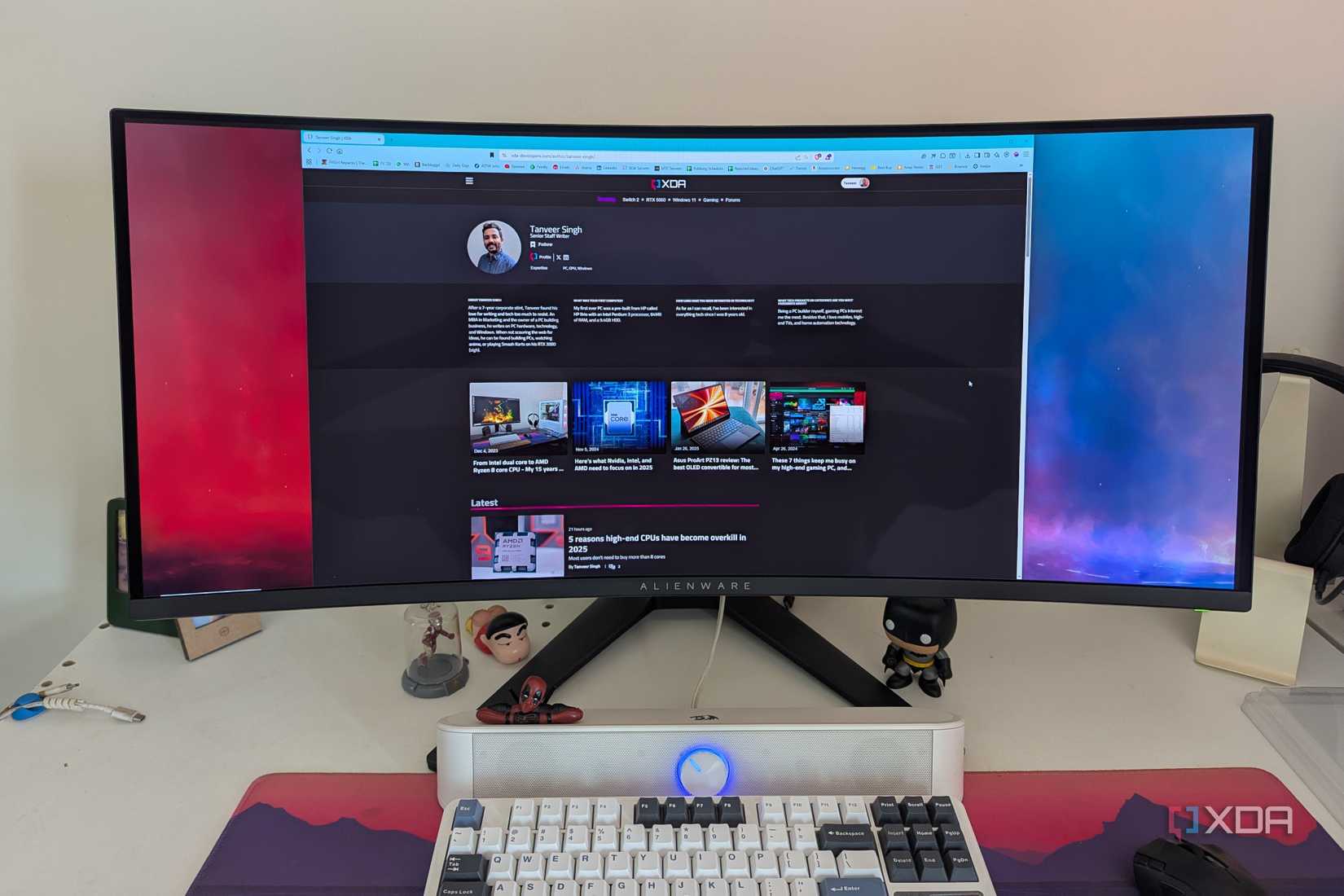After going back and forth on my decision to upgrade my monitor, I finally switched to an OLED display a few weeks ago. I obviously knew that the AW3423DWF was a 34" curved ultrawide OLED monitor, but I hadn't truly grasped what that form factor would mean for my setup. Besides the physical footprint of the display, the peculiarities of the 21:9 aspect ratio and the differences between IPS and OLED panels caught me off guard.
6 You're not prepared for the depth of the monitor
And now I need a new desk
I would be lying if I thought a 34" curved ultrawide display wouldn't dominate my desk. My 27" monitor already felt a bit too close to my eyes while working, so the upgrade was sure to take things up a notch. That said, I thought the new display wouldn't make a huge difference to my setup in terms of how far I sit from the screen — I couldn't be more wrong.
Due to the panel being curved and ultrawide, the stand needed to support it is massive. Not only is the entire assembly heavier than I'd expected, but its depth brings the screen considerably closer to my face. I can feel the effect on my eyes after 6–7 hours of writing every day. Not only that, I'm also struggling for space on the desk. I now have to manage my deskmat on a smaller portion of the desk, besides being forced to keep the soundbar on the deskmat instead of the desk.
I know buying a monitor arm would solve most of these issues, but I'm not willing to do that right now. I like the look of the monitor's stand, and believe a larger desk would be a better fix for my space constraints. I had to move to a bigger desk sooner or later anyway; the new monitor has just accelerated the timeline.
5 Cutscenes and menus in games are still 16:9
An instant immersion killer
This isn't a major issue, but it still came as a surprise to me. When I was reading up about ultrawide monitors, I found out that support for the 21:9 aspect ratio is a bit challenging, but still manageable. Besides, there's nothing a few mods won't solve. However, I didn't know that even in the games that support the 3440 x 1440 resolution of the AW3423DWF, the menus and cutscenes would still be locked to 16:9.
The huge black bars might not remain on the screen for long, but they still break the immersion, especially in the cutscenes. The enhanced enjoyment of a curved monitor is undoubtedly a perk, but inconsistent support for the 21:9 aspect ratio somewhat ruins the experience. I haven't yet looked online for any workarounds, but I'm sure there would be clever solutions if I ever get too annoyed by immersion-breaking cutscenes.
4 The FPS drop is significant
My GPU feels older than it really is

Again, this was something I was aware of, but the extent of the performance hit still shocked me. The 3440 x 1440 resolution is fairly higher than standard 1440p, but it still doesn't feel like a huge jump psychologically. After consuming a few videos about the expected performance drop, I concluded that there wouldn't be a linear impact on the FPS.
However, the in-game settings I was used to, and the age of my GPU meant that a tangible hit to my gaming experience was in store for me. From running Cyberpunk 2077 at 60+ FPS consistently, using Ultra ray tracing settings, I had to settle for around 50–55 FPS. Lowering the settings makes the game smoother, but then I lose out on the eye candy I'm used to. My RTX 3080 was already feeling old before the monitor upgrade; now, it feels like a new GPU is overdue.
I see a similar drop in performance when playing other titles like Alan Wake 2, Death Stranding, and Control. That said, I'd still wait at least two years before buying a new GPU, managing with optimized settings, a mix of new and old titles, and experimenting with tools like Lossless Scaling.
3 A larger screen doesn't mean an automatic boost to productivity
I still use only half the screen when working

One of the many advantages of ultrawide monitors is often the increased productivity due to the additional screen real estate. You can view multiple windows simultaneously, cut down on the switching time, and finish your work faster. For me, however, ditching my old habits has been a challenge. I still find myself using around half the screen when writing, working on a single browser window the same way I've been doing for years.
I know I can technically have two browser windows open side by side — one for my CMS, and the other for doing research — but it's easier said than done. I find it easier to continue working the way I'm used to, and changing my workflow would probably take a few more weeks (or months). I have a theory why I still like to work the old way: maybe I like seeing the wallpapers I've set up on Wallpaper Engine. Using the entire screen size would rob me of this little pleasure.
2 Missing pixels due to pixel shifting
A disconcerting gap between the image and the bezels
This one almost gave me an anxiety attack. The day I set up my new monitor, configured the OSD settings, and took it for a spin, I noticed something weird after running the pixel refresh for the first time. The available screen size was reduced by a few millimeters on two of the four sides of the panel. I thought maybe I was noticing this for the first time, and immediately Googled if my expensive OLED monitor was defective.
It turns out that this was a feature, not a bug, a result of "pixel shifting," where the monitor moves the image around periodically to prevent burn-in. After every pixel refresh cycle, the sides of the screen exhibiting the "gap" from the bezel keep changing. In a way, this isn't temporary at all, as I have to keep seeing this weird gap 24/7, only at different edges of the screen over time. That said, it protects my expensive display from burn-in, and doesn't really steal pixels from me (the panel is slightly larger than 3440 x 1440 to allow for pixel shifting).
1 QD-OLED isn't a clear winner over IPS
The downsides are readily apparent
Although my new QD-OLED display can run circles around my older IPS monitor in terms of true blacks and HDR, it's not a flawless panel. During the day, even a small amount of sunlight creeping in from the window is enough to turn the otherwise authentic black areas of the screen to purple. It's immediately visible, and is something I have learned to live with, since I don't like shutting the sunlight out in the day.
Then there's the inferior brightness issue, something older QD-OLED panels like this one are known to exhibit. IPS displays might not be able to reach the contrast levels boasted by OLEDs, but they can get a lot brighter. My older IPS monitor can achieve around 100 nits of additional full-screen brightness compared to my brand-new OLED model. This downside manifests in bright scenes where QD-OLEDs can be significantly dimmer than LEDs and even WOLEDs.
Lastly, as a writer, I need to look at text an awful lot during the day, and the subpar text clarity really gets to me. I thought this was always exaggerated, but after using the new OLED monitor for a week, I had to look for a solution. Enabling ClearType didn't help much, so I downloaded MacType, which produced slightly better results. Text clarity is still not fixed, but I've reached a point where I can make it to the end of the day without cursing out loud.

The Alienware AW3423DWF is a QD-OLED monitor boasting 1000 nits of peak brightness, ultra-fast response times, and a curved 34" ultrawide panel.
Ultrawide OLEDs aren't perfect, but I still love mine
Despite the many downsides of the QD-OLED panel and the 21:9 form factor, I wouldn't go back to my IPS monitor. I was looking forward to upgrading to an OLED monitor, and grabbed the AW3423DWF when it dropped to around $600 in my region. That's still not a deal, but given that this monitor launched for over $1,000, I'd consider it a smart purchase. Besides, any other ultrawide OLED in my region was significantly pricier anyway. I'm loving OLED gaming right now, and don't wish to upgrade anything else in my setup anytime soon.
.png)











 English (US) ·
English (US) ·